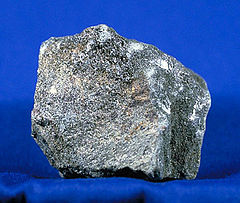Chlorite group
| Chlorite group | |
|---|---|
 |
|
| General | |
| Category | Phyllosilicates |
|
Formula (repeating unit) |
(Mg,Fe)3(Si,Al)4O10 (OH)2·(Mg,Fe)3(OH)6 |
| Crystal system | Monoclinic 2/m; with some triclinic polymorphs. |
| Identification | |
| Color | Various shades of green; rarely yellow, red, or white. |
| Crystal habit | Foliated masses, scaley aggregates, disseminated flakes. |
| Cleavage | Perfect 001 |
| Fracture | Lamellar |
| Mohs scale hardness | 2–2.5 |
| Luster | Vitreous, pearly, dull |
| Streak | Pale green to grey |
| Specific gravity | 2.6–3.3 |
| Refractive index | 1.57–1.67 |
| Other characteristics | Folia flexible – not elastic |
The chlorites are a group of phyllosilicate minerals. Chlorites can be described by the following four endmembers based on their chemistry via substitution of the following four elements in the silicate lattice; Mg, Fe, Ni, and Mn.
In addition, zinc, lithium, and calcium species are known. The great range in composition results in considerable variation in physical, optical, and X-ray properties. Similarly, the range of chemical composition allows chlorite group minerals to exist over a wide range of temperature and pressure conditions. For this reason chlorite minerals are ubiquitous minerals within low and medium temperature metamorphic rocks, some igneous rocks, hydrothermal rocks and deeply buried sediments.
The name chlorite is from the Greek chloros (χλωρός), meaning "green", in reference to its color.
The typical general formula is: (Mg,Fe)3(Si,Al)4O10(OH)2·(Mg,Fe)3(OH)6. This formula emphasizes the structure of the group.
Chlorites have a 2:1 sandwich structure (2:1 sandwich layer = tetrahedral-octahedral-tetrahedral = t-o-t...), this is often referred to as a talc layer. Unlike other 2:1 clay minerals, a chlorite's interlayer space (the space between each 2:1 sandwich filled by a cation) is composed of (Mg2+, Fe3+)(OH)6. This (Mg2+, Fe3+)(OH)6 unit is more commonly referred to as the brucite-like layer, due to its closer resemblance to the mineral brucite (Mg(OH)2). Therefore, chlorite's structure appears as follows:
That's why they are also called 2:1:1 minerals.
An older classification divided the chlorites into two subgroups: the orthochlorites and leptochlorites. The terms are seldom used and the ortho prefix is somewhat misleading as the chlorite crystal system is monoclinic and not orthorhombic.
Chlorite is commonly found in igneous rocks as an alteration product of mafic minerals such as pyroxene, amphibole, and biotite. In this environment chlorite may be a retrograde metamorphic alteration mineral of existing ferromagnesian minerals, or it may be present as a metasomatism product via addition of Fe, Mg, or other compounds into the rock mass. Chlorite is a common mineral associated with hydrothermal ore deposits and commonly occurs with epidote, sericite, adularia and sulfide minerals. Chlorite is also a common metamorphic mineral, usually indicative of low-grade metamorphism. It is the diagnostic species of the zeolite facies and of lower greenschist facies. It occurs in the quartz, albite, sericite, chlorite, garnet assemblage of pelitic schist. Within ultramafic rocks, metamorphism can also produce predominantly clinochlore chlorite in association with talc.
...
Wikipedia
